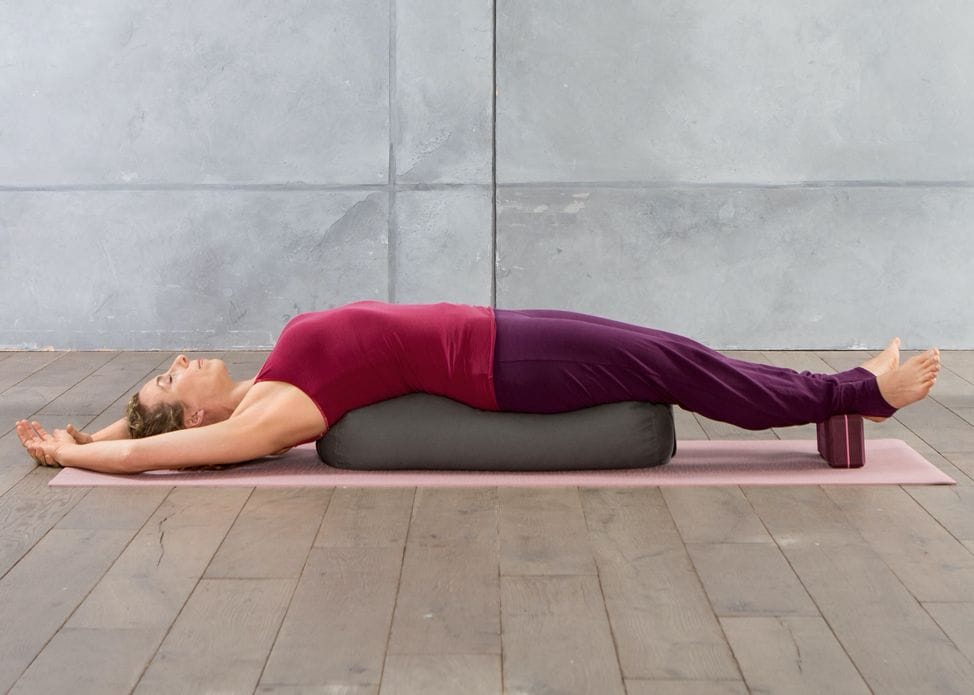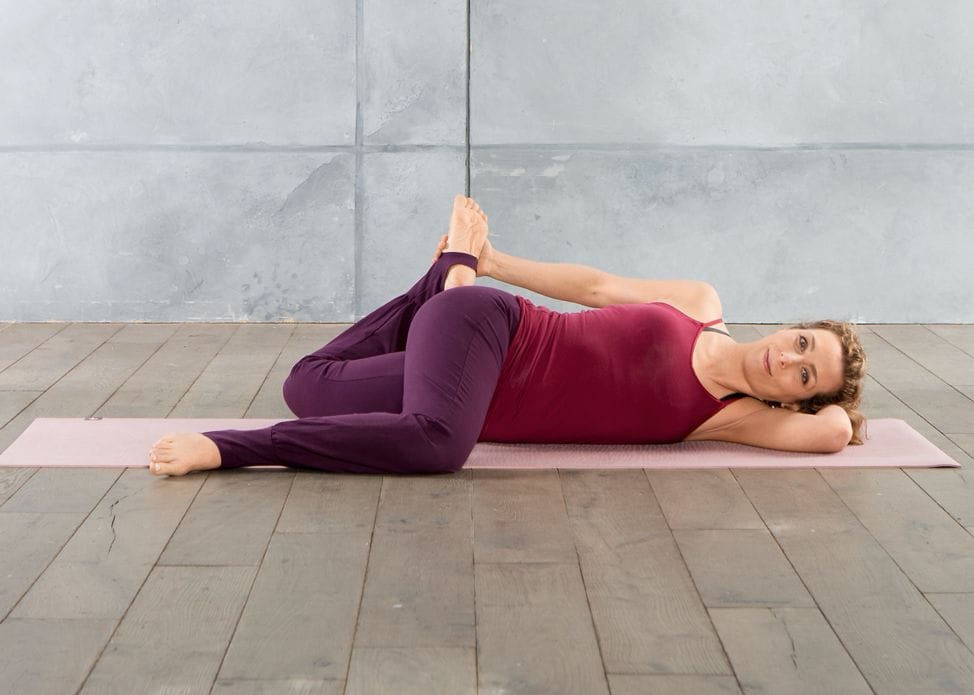Releasing Respiratory Problems & Breathing Difficulties

Respiratory problems often present in the form of breathing difficulties or shortness of breath. An adult normally breathes, on average, twelve to eighteen times per minute. Yoga practitioners often manage with six to eight breaths as they practice certain techniques that train deep breathing. Environmental influences, psychological problems, and illnesses such as asthma can also restrict breathing.
Releasing Respiratory Problems through Yoga
By Stefanie Arend
From a holistic perspective, there is a difference between problems with inhalation and exhalation: difficulties with inhalation are linked in the figurative sense with topics such as rejection and non-acceptance, and problems exhaling relate to difficulties in giving up and letting go.
Possible questions for reflection on respiratory problems are:
~ What is stopping me from breathing?
~ What am I unable to accept?
~ What am I unable to let go of?
In Traditional Chinese Medicine, it is usually the lungs, spleen, and kidneys that are treated.
Respiratory problems can be influenced positively not only through yoga or sports but also with the right choice of nutrition. A diet that is low in salt can improve lung function and alleviate possible narrowing of the bronchial tubes. The same recommendations apply for allergies as allergic reactions frequently occur in the area of the respiratory tract. Histamine can play an important role here. If the body comes into contact with an allergen, more of this messenger substance is released, provoking the immune reaction. A high intake of vitamin C—for example, dark green vegetables, peppers, or parsley—can help reduce the distribution of histamine and reduce respiratory problems. Sauerkraut or citrus fruits are less suitable here; they are rich in vitamin C but are a source of histamine in themselves, and also tend to stimulate the release of histamine. Additionally, it is advisable to cut out dairy products, as they often have a congesting effect and can, therefore, hamper the breathing.
Yoga Poses for Releasing Respiratory Problems & Breathing Difficulties
Bridge (Setu Bandha Sarvangasana)
This position opens up the thoracic spine, the heart chamber, and the shoulders.

Effect
The stretch is particularly effective for the meridians of the stomach, spleen, kidneys, liver, lungs, heart, and pericardium.
Practicing the exercise
Place a yoga bolster lengthways on the mat and a block at the lower end of the mat. Sit at the lower end of the yoga bolster and lean back so that your shoulder blades are on the upper end of the bolster.
Place your shoulders and head on the floor. Rest your head on a blanket or small cushion if the position is uncomfortable for the cervical spine. Take your arms back above you slowly and place them next to your head.
Stay in Bridge for three to five minutes. Either push yourself up gently with an activated pelvic floor or roll out of the position sideways. Place the props to one side and come into Relaxed Supine Position, relaxing into it for several minutes.
Lying Butterfly (Supta Baddha Konasana)
This exercise opens your pelvic area, has a positive effect on the organs of the lower abdomen, stretches the insides of the legs. It also expands your chest area, which can help you with deep breathing.

Effect
With Lying Butterfly, the focus is on the meridians of the liver, kidneys, and spleen, and—when the arms are outstretched—on the lungs, heart, and pericardium meridians as well.
Practicing the exercise
Lie back on the mat; place a yoga block under your head, and a second one at shoulder height under your thoracic spine. Alternatively, you can use a soft cushion under your head. Bring the soles of your feet together, and let your knees sink outwards slowly. Should the stretch be too intense on the insides of the legs or the groin, you can place more blocks or cushions under your knees. Stretch the arms out long next to your head, and place them on the floor so that you can feel a stretch in the chest and shoulder area. If your fingertips go numb doing this or you do not have the range of motion to do this, change the position of the arms so that the hands are more at your side or on your stomach.
Stay in the position for three to five minutes. Take the arms back next to your body, close your legs, and push yourself up with an activated pelvic floor. Place the props to one side and relax into Supine Position (see image below).
Cat Pulling Its Tail
In this position, the stomach organs are gently massaged by the rotation and your breathing. It also gently stretches the front side of the thighs, which are often shortened nowadays as so many people sit for long periods. The slight stretch in the spine also has a positive effect on the health of the back so that the fascia in the lower back that is prone to pain is stimulated.

Effect
Cat Pulling Its Tail mainly works on the meridians of the stomach, spleen, gallbladder, and bladder, on the arms, and also on the meridians of the lungs, heart, and pericardium.
Practicing the exercise
Lie on your left side and position your head comfortably on your left arm. Bend your right knee and angle your leg at 90 degrees in front of the body. Now also bend your left knee and grip your left ankle with the right hand behind your back, so that you come into a gentle rotation.
Alternatively, you can also grip your pants or use a yoga belt. Either remain balanced lying on the side, or shift your weight back a little more. Direct your breath into your stomach to strengthen the detoxifying effect of this exercise on your stomach organs.
Hold the position for three to five minutes, then release the hand from your foot, turn back to the center, and change sides.
I suggest always ending your sessions with a lying pose. One of my favorites is the Supine pose:

In addition to the poses, please check out my YouTube Channel to access this video to reduce stress with the right breathing technique:
Excerpted from Be Healthy with Yin Yoga: The Gentle Way to Free Your Body of Everyday Ailments and Emotional Stresses by Stefanie Arend (She Writes Press, August 2019). For more information, visit: https://www.yinyoga.de/en
Photo credit: Forster & Martin Fotografie, Munich
Click HERE to Connect with your Daily Horoscope on OMTimes!
You will also enjoy Yoga: The Meeting Point of Science and Spirituality
About the Author
Stefanie Arend is a renowned Yin Yoga instructor, holistic health coach, nutritionist, and energy worker. As the first German author to focus exclusively on Yin Yoga, she is the author of six books, including the classic bestseller, Yin Yoga: The Gentle Path to the Inner Center (2011) and Surya Namaskar: The Sun Salutation (2014), both of which were named Best Yoga Book of the Year in German-speaking countries. Be Healthy with Yin Yoga is her first English language book. For more information about Stefanie or to watch her videos, please visit her website and YouTube channel.
OMTimes Magazine is one of the leading on-line content providers of positivity, wellness and personal empowerment. OMTimes Magazine - Co-Creating a More Conscious Reality





